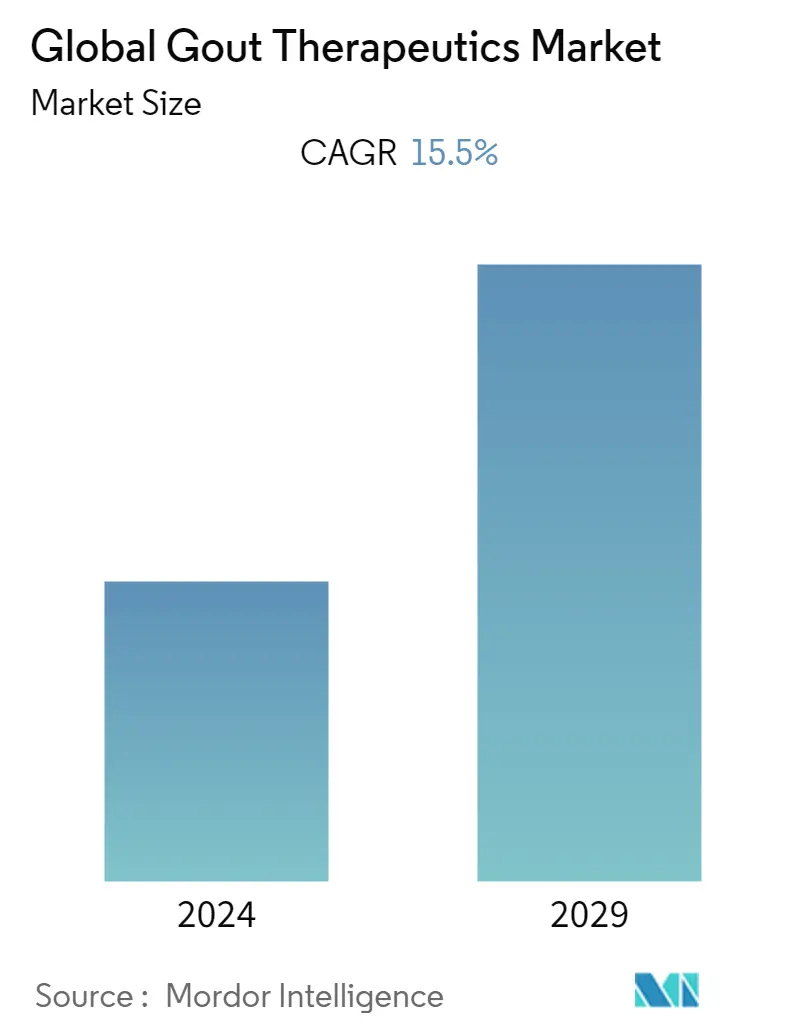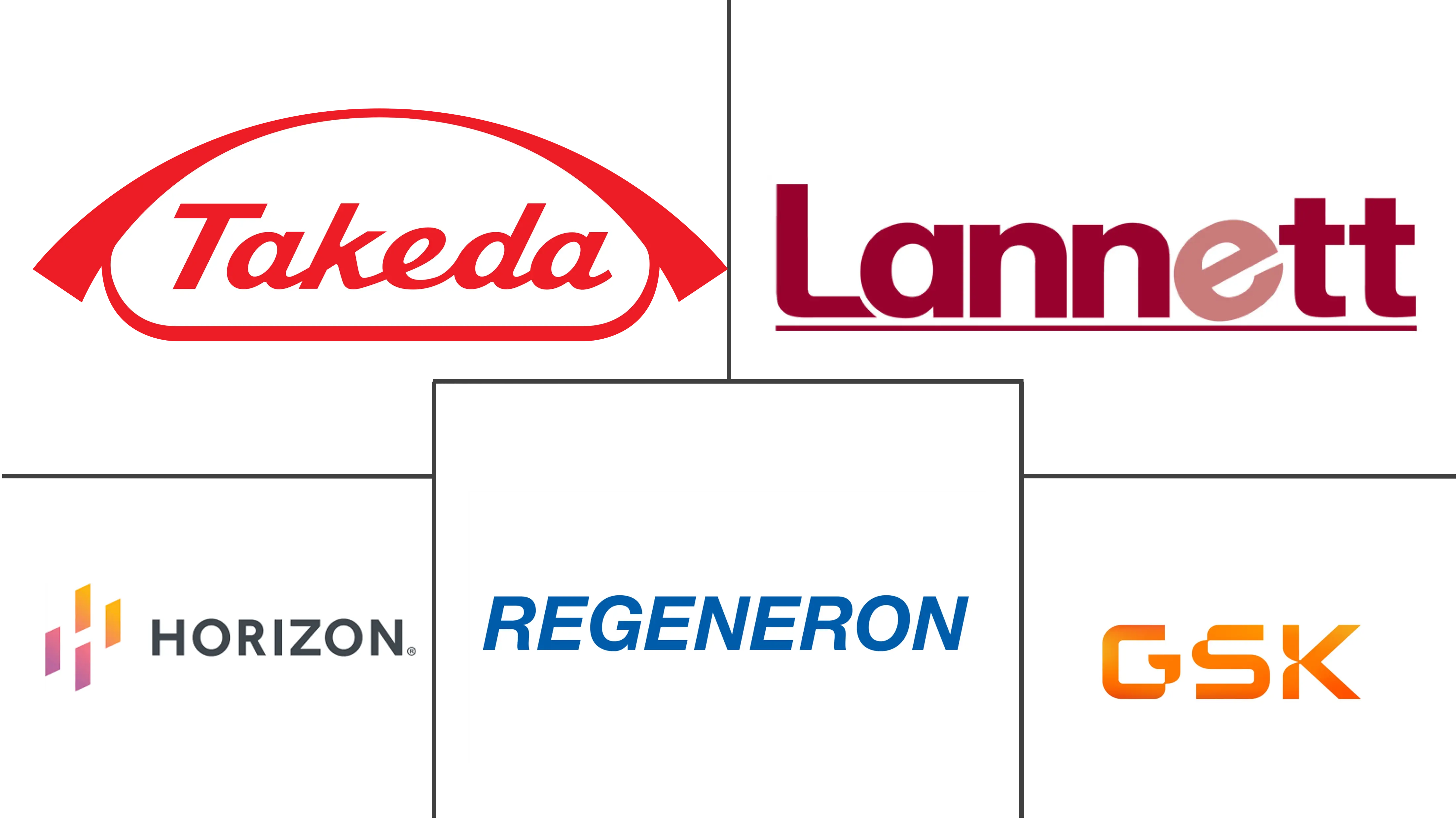Market Size of Global Gout Therapeutics Industry

| Study Period | 2019 - 2029 |
| Base Year For Estimation | 2023 |
| CAGR | 15.50 % |
| Fastest Growing Market | Asia Pacific |
| Largest Market | North America |
| Market Concentration | Medium |
Major Players
*Disclaimer: Major Players sorted in no particular order |
Need a report that reflects how COVID-19 has impacted this market and its growth?
Gout Therapeutics Market Analysis
The Gout Therapeutics market is anticipated to grow with a CAGR of 15.5%, over the forecast period (2022 - 2027).
The COVID-19 pandemic has significantly impacted market growth. The onset of the COVID-19 pandemic has caused a nationwide lockdown with the suspension of non-urgent scheduled visits and hospitalizations which resulted in the delayed diagnosis of patients suffering from gout. For instance, according to an article published by the Rheumatology Journal, in March 2022, titled " Gout and the COVID-19 pandemic', due to concomitant cardiometabolic disorders, people with gout are expected to be at an elevated risk of adverse outcomes following COVID-19 infection. In addition, as per the same source, the COVID-19 epidemic has posed several challenges for people suffering from gout as well as a lack of guidance on the management of gout during the pandemic and scant research evaluating the effects of COVID-19 infection on gout sufferers has impacted the growth of the studied market during the pandemic. Additionally, according to an article published by the Annals of Rheumatic Diseases, in March 2022, titled 'Colchicine prophylaxis is associated with fewer gout flares after COVID-19 vaccination', it has been observed that the COVID-19 vaccine was negatively associated with colchicine prophylaxis and was linked to an elevated risk of gout flares, which primarily appeared in the first month following each dosage. Thus, COVID-19 has a negative impact on the treatment as well as the supply of therapeutics related to gout.
The factors attributed to the growth of the market are the growing adoption of biologics and rising research and development activities on regenerative medicines, the rising prevalence of gout with increasing alcohol consumption, and technological advancements in imaging modalities that improved the understanding of gout.
In addition, the factors that increase the risk of developing gout are obesity, dietary factors, comorbid conditions, and novel associations of gout with other comorbidities, such as erectile dysfunction, atrial fibrillation, obstructive sleep apnea, osteoporosis, and venous thromboembolism have been reported. For instance, according to 2022 statistics published by World Obesity Federation, it has been observed that 31.5% of men and 40.2% of women are living with obesity in Mexico in 2020. Also, according to the Eurostat report in July 2021, more than half (53%) were overweight (36% pre-obese and 17% obese) in Europe in 2020. As per the same source, the highest share of the obese population was found in the people aged 65 to 74 (66%) and the lowest among those aged 18 to 24 (25%). Thus, a high body mass index increases the risk of developing gout by increasing the serum uric acid level in the body and leads to hyperuricemia which decreased the renal secretion of urate. This is expected to increase the demand for effective treatment and therapeutics which is in turn anticipated to propel the market growth.
The rising incidence and prevalence of gout among the population are also contributing to the market growth. For instance, according to an article published by the Annals of Rheumatic Diseases, in June 2021, titled 'Has the gout epidemic peaked in the UK? A nationwide cohort study using data from the Clinical Practice Research Datalink, from 1997 to across the COVID-19 pandemic in 2021', it has been observed that the prevalence rate of gout has been increased from 0.98%in 1997 to 2.33% in 2021. As per the same source, the incidence of gout increased by 0.98/1,000 persons in 2021. Thus, the high burden of gout is expected to increase the demand for drugs treating this condition, which is anticipated to fuel the market growth over the forecast period.
However, the side effects of gout therapeutics drugs and the high indirect costs of gout therapeutics are the factors that are impeding the growth of the market.
